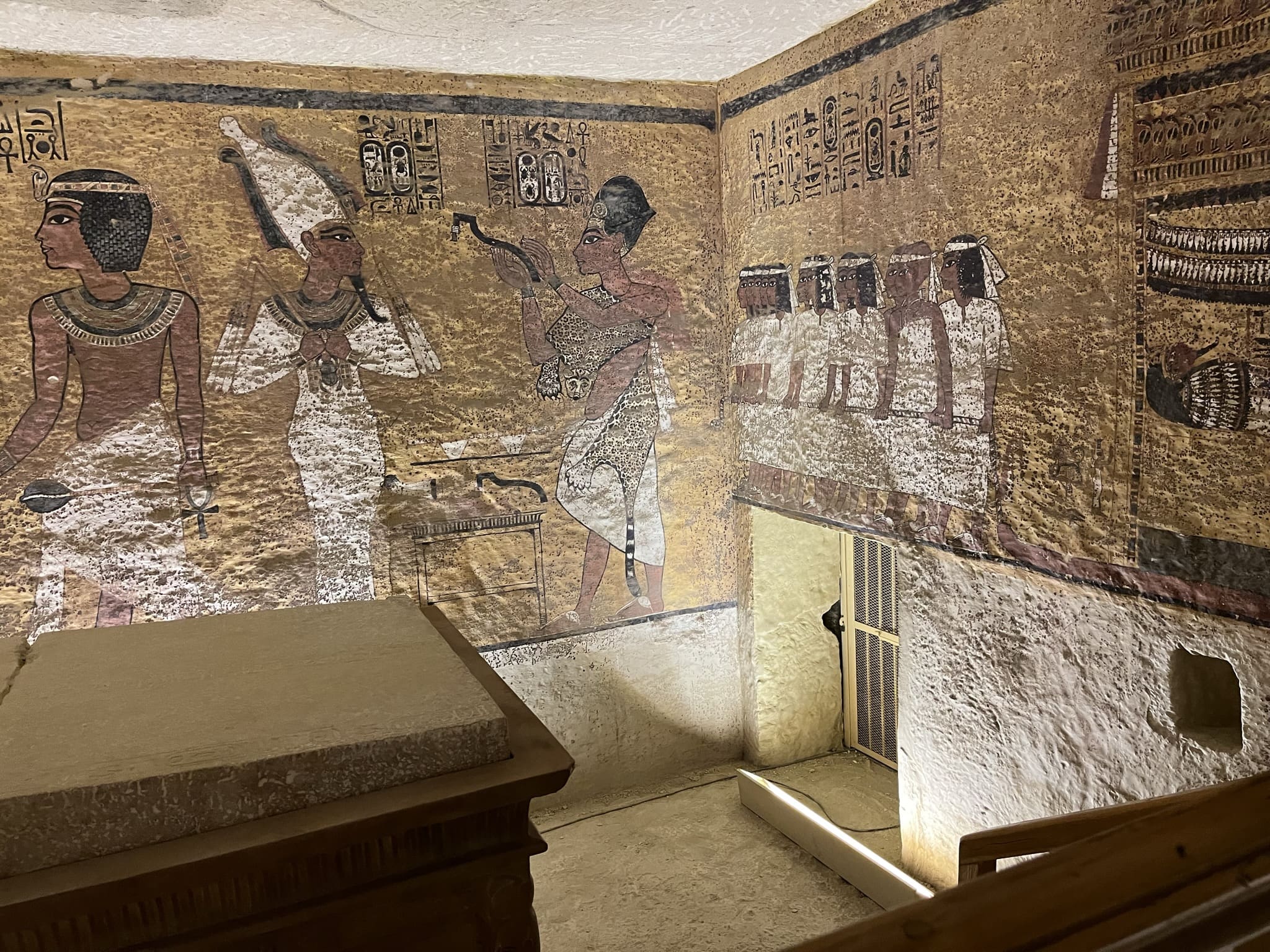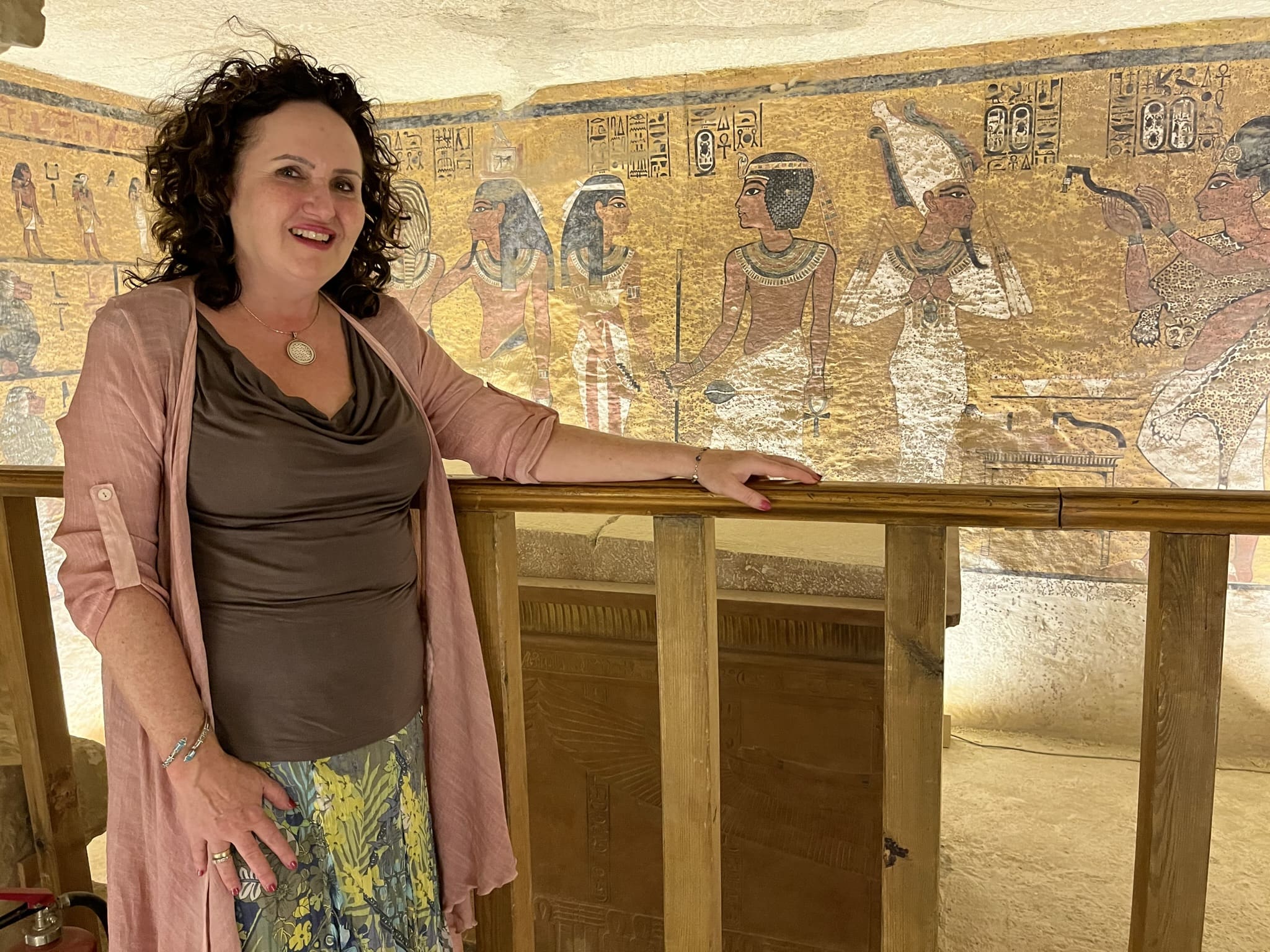By Laura Ranieri Roy
This past August, I was invited to be an Egypt expert on a new Fox Nation documentary, Tales of Terror: Curse of King Tut. This series, premiering on Fox Nation Thursday, October 31, 2024, explores one of history’s most haunting mysteries—the so-called curse of King Tutankhamun. I was deeply honored to be featured as one of the Egyptologists bringing the legend of this ancient curse to life, alongside experts like the esteemed Dr. Zahi Hawass. Filming in New York was fun and it was thrilling to share stories around a tale that’s both eerie and fascinating—one that continues to puzzle and haunt us even today.
The legend of Tutankhamun’s curse began when Howard Carter discovered the boy king’s tomb on November 4, 1922. While it was a day that shook the world – and would mesmerize people around the globe with the golden treasures within – a triumph in archaeology; it also heralded, some say. Yet it also, some say, opened the door to a chain of untimely events. Misfortunes, sickness – event death. Stories of mysterious demises, eerie occurrences, and sinister warnings have surrounded Tutankhamun’s final resting place, inspiring rumors of a deadly curse that spares no one who dares disturb the king’s eternal sleep. Was the curse real?
The Curse: A Magic Brick with an Obscure Spell
The mystery of the curse, some say, began not with whispers in the night, but with a single stone—a magic brick hidden in the treasury at the foot of the jackal-headed god Anubis. Inscribed on this brick was a haunting warning. But was it really a curse?
“It is I who hinder the sand from choking the secret chamber, and who repel that one who would repel him with the desert flame. I have set aflame the desert, I have caused the path to be mistaken. I am for the protection of the deceased.”
Not quite what one may have expected to set the wheels of death in motion. This was not really a curse; it was a declaration of supernatural protection over Tutankhamun’s tomb.
Even so, once Lord Carnarvon, the wealthy sponsor of the expedition, met his untimely death a month or so after entering the burial chamber did the world begin tobegan to tremble at the thought of a curse.
Beyond the magic brick, there was a lot of superstition in the air. After all, the 1920s was an age when spirituality and “table tapping” was all the rage, especially among the upper class of Great Britain. Carnarvon was a believer himself. With the announcement of the discovery of a virtually untouched tomb (despite two robberies in antiquity), many began to speculate about a curse.
The British journalist Marie Corelli wrote in the Times of London: “The most dire punishment follows any rash intruder into a sealed tomb.”
Another journalist and archaeologist Arthur Weigel, invited to cover the burial chamber opening in March of 1923, noticed Carnarvon’s casual jesting on the occasion. He famously commented, “If he goes down in that spirit, I give him six weeks to live.” It was an offhand remark that eerily came true. Even Arthur Conan Doyle, the famous Sherlock Holmes writer was an ardent “spiritualist” who postulated the cause of death may have been elementals, spirits – or curses that guarded the tomb of Tutankhamun.
The Death of Lord Carnarvon
In April 1923, Lord Carnarvon succumbed to a fatal infection from an infected mosquito bite that he had accidentally aggravated while shaving. It turned to sepsis – and of course there was no antibiotics at the time. More strange occurrences happened on his death.
As he lay on his deathbed in Cairo, the lights of the city flickered and then went out—a blackout that seemed ominously timed. Now, if you have traveled in Egypt as I have even today (let alone in 1923), blackouts are a regular occurrence in Cairo and throughout the country. However, there was more: His beloved dog, a little Jack Russell called Suzie back in England, reportedly sat up, howled and died at that exact moment. It was reported by his Scottish maid back home at the exact instant – despite the time change. To be sure, Carnarvon’s death had more than a tinge of mystery about it, but it was only the beginning.
A Trail of Tragedies
A string of eerie incidents followed. In July 1923, Prince Ali Kamel Fahmy Bey, who had visited the tomb, was murdered by his wife in London. Then, a half brother of Carnarvon, Audrey Herbert also contracted sepsis and died after getting all his teeth extracted. The grim list went on.
Consider Hugh Evelyn-White, a British archaeologist who worked at the tomb. By 1924, he had witnessed enough death with a loss of a close friend to believe that the curse was real. In despair, he took his own life, leaving a note that said, “I have succumbed to a curse which forces me to disappear.”
The Haunted Relic
Sir Bruce Ingram, a friend of Carter, received a rather macabre gift—a mummified hand wearing a bracelet inscribed with a curse. Shortly after receiving it, Ingram’s house burned down. When he rebuilt it, a flood destroyed it. The mummified hand itself was said to carry a warning to anyone who disturbed the dead, and for Ingram, the warning rang true.
Did a Curse Take Governor Lee Stack?
Some deaths seemed linked to Tutankhamun’s curse in unexpected ways. In November 1924, Sir Lee Stack, the Governor-General of the Anglo-Egyptian Sudan, was assassinated while driving through Cairo. Though he had no direct connection to the tomb, many believed the curse extended its reach to those merely associated with its discovery. To this day, some locals insist that Stack’s fate was no coincidence.
Microbes, Mold, and Toxins
But aside from ghosts and elementals and eerie ancient forces, could there be a more scientific explanation for deaths associated with entering ancient tombs? Certainly. And these have been explored as possible options to “the curse”.
Recent studies have shown that ancient tombs contain dormant, potentially deadly fungi and bacteria that can cause severe allergic reactions and respiratory issues. Aspergillus niger and Aspergillus flavus, both toxic molds found in old tombs, can result in symptoms as severe as bleeding in the lungs. Additionally, sarcophagi sealed for millennia can release ammonia gas, formaldehyde, and hydrogen sulfide—chemicals that may cause burning in the eyes and nose, and even mimic pneumonia-like symptoms.
These deadly microbes appeared to be the culprit in the case of deaths associated with a medieval Polish tomb. 12 archaeologists entered the tomb of Casmir IV (1447-1492) in 1973. 4 of them died within a few days due to exposure to deadly “aspergillus flavus” microbes.
Yet in the case of Tutankhamun, the case for molds and toxins killing people remains dubious. Highly unlikely. Ancient mould – brown spots on the wall – were studied and proven to have been dried and dead for thousands of years…No connection.
Still, for some, the unexplained illnesses and deaths are proof enough that something dark lingers in the air of Tut’s tomb!
A Timeline of Mysterious Deaths
The following incidents are just a few more in a series of deaths that fuel the legend of Tutankhamun’s curse:
- November 20, 1924: Sir Lee Stack, Governor-General of Sudan, assassinated.
- March 24, 1926: Dr. Georges Benedite, an Egyptologist, died after visiting the tomb.
- May 31, 1926: Dr. Aaron Ember, who was working on the Egyptian Book of the Dead, perished in a house fire.
- April 6, 1928: Arthur Mace, archaeologist who worked with Carter in the tomb died of pleurisy.
- November 16, 1929: Richard Bethell, Carter’s secretary, was allegedly smothered to death.
- March 2, 1930: Lord Westbury, father of Richard Bethell, leaped from a window, leaving a note that spoke of “horrors” he could no longer bear.
Did each of these individuals fall prey to a supernatural curse or toxic mold, or were these tragic events simply coincidences?
The Science Behind the “Curse”
What about those who survived the curse of Tut? Evidently, there were many – and they lived quite a long time.
In 2002, The BMJ (formerly British Medical Journal) published a study analyzing the lifespans of those who had entered the tomb. Contrary to popular belief, researchers found that those who entered the tomb lived an average of 20 years after the discovery, with an average age of death around 70. Statistically, they outlived others in their age and social class. Even Lady Evelyn Herbert, Carnarvon’s daughter and one of the first in the tomb lived well into her 70s.
In essence, the so-called “curse” did not claim the lives of tomb visitors or associates as frequently or as swiftly as legend would suggest. As for Howard Carter, the man who started it all, he lived until 1939, passing away at the age of 64 with Hodgkin’s Disease. Not a bad lifespan for a chain smoker living in these times. The curse? Carter once called it all “tommy rot” –and said, “I curse anyone who says there is a curse.”
The True Curse of the Pharaoh
My take? The real curse might be on the tombs themselves, not on the archaeologists or visitors. Centuries-old tombs are now besieged by tourism, with crowds of visitors bringing moisture that fuels mold growth, slowly eating away at the coloured walls, reliefs, and irreplaceable artifacts. Many tombs are now closed for emergency conservation to prevent further damage.
The pressing question is this: how can we protect these ancient sites from the toll of tourism?
The answer lies in sustained conservation, digitization (to capture every detail before colors fade), and even the creation of replica tombs to relieve the impact on original sites.
The “curse” of Tutankhamun is a tale that may forever intrigue us, shrouded in mystery. But certainly, that may be said today for ALL of Ancient Egypt. So many stories that never get old!







